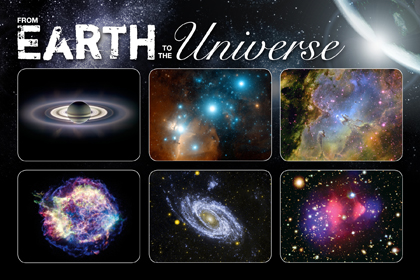For Release: February 24, 2009
CXC
A worldwide exhibition of large-scale astronomical images has launched in the United States under the banner of the International Year of Astronomy 2009 (IYA2009). The "From Earth to the Universe" (FETTU) project is designed to bring the undeniable beauty of astronomy to the general public in a series of free showings across the country, which have begun with a traveling image exhibit now open at Tucson International Airport in Arizona.
FETTU (www.fromearthtotheuniverse.org) is a major project of both the US and global efforts for IYA2009. With images taken from both ground- and space-based telescopes, FETTU showcases the incredible variety of astronomical objects that are known to exist - planets, comets, stars, nebulae, galaxies, clusters, and more. The exhibit also shows how some of these objects look different when viewed across the electromagnetic spectrum, from the ultraviolet and visible light to infrared, X-rays and gamma rays.
FETTU is being shown in non-traditional public venues such as parks and gardens, shopping malls, metro stations and airports in major cities across the world. The FETTU images have been selected for their stunning beauty to engage members of the general public who might normally ignore or avoid astronomy. With short, but informative captions on each panel, the goal is introduce some basics of the science involved once an individual has been drawn to the image.
In the US, FETTU is being sponsored by NASA and will appear in semi- permanent installations in Atlanta and Chicago later this spring. The traveling version of FETTU, with its first stop in Tucson, will then move to Memphis in April. More FETTU locations are being planned across the US and an enhanced schedule is being developed.
Several editions of FETTU will also be appearing in the San Francisco and the Bay Area beginning in May. The funding for these comes from to NASA's Lunar Science Institute, the Fermi and Swift missions through Sonoma State University, and several other organizations. Also, the NASA IYA Student Ambassador program is facilitating a FETTU exhibit in Madison, Wisc.
With NASA support, FETTU panels for the visually impaired are being prepared. The caption material for all of the images in the US collection of 50 images is available in both English and Spanish.
"It's very rewarding to see FETTU taking shape across in the United States thanks, in large part, to NASA," said Kim Kowal Arcand of the Chandra X-ray Center and principal investigator for the NASA FETTU grant. "It's also amazing to see how it has taken off around the world."
With 2009 underway, FETTU is already being showcased in a variety of formats - both as physical installations and digital displays - in over 40 countries around the globe. These worldwide exhibits have been funded through a variety of local resources and are organized by each individual location. For a full list of known FETTU exhibits - both in the US and internationally -- visit http://www.fromearthtotheuniverse.org/table_events.php.
FETTU is one of 11 global cornerstone projects being supported by the International Astronomical Union's IYA2009 efforts. To learn more about IYA2009 internationally, the cornerstone projects, and other activities please visit http://www.astronomy2009.org
Media contacts:
Megan Watzke
Chandra X-ray Center, Cambridge, Mass.
617-496-7998
cxcpress@cfa.harvard.edu
Douglas Isbell
U.S. Single-Point-of-Contact for IYA2009
disbell@astronomy2009.us
520-991-0380



